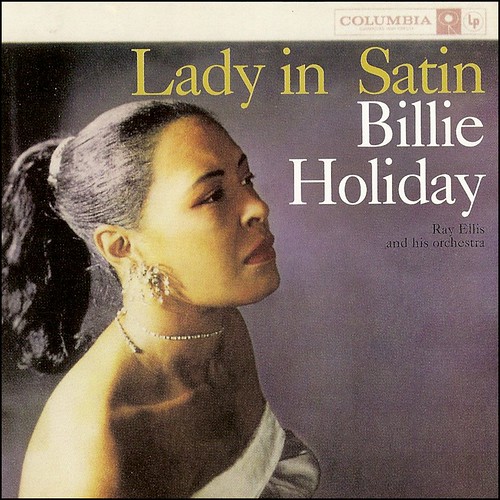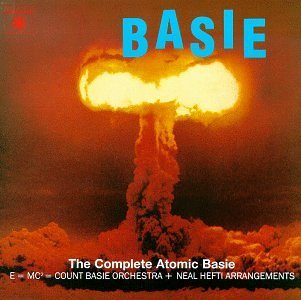
Tracks: Oh Boy!//Not Fade Away//You've Got Love//Maybe Baby//It's Too Late//Tell Me How//That'll Be the Day//I'm Lookin' for Someone to Love//An Empty Cup (and a Broken Date)//Send Me Some Lovin'//Last Night//Rock Me My Baby
Well, as Police Chief Klein once said regarding the Ramones, "They're ugly, ugly people".
I should be honest and admit that I don’t think any rock album at this point is going to get full marks. The genre was still in its relative infancy! Furthermore, most rock albums at the time were just quickly-assembled packages of recent singles with b-sides and album cuts. Add to this the fact that bare-bones rock & roll has never exactly been my favourite genre, and you can see why I might not exactly go nuts over this stuff.
The “Chirping” Crickets does, however, present us with quite a lot worth going nuts over. Buddy Holly’s influence on the nature of rock is difficult to overstate. The only guy of comparable importance is Chuck Berry, and while the two guys do share a lot in common in terms of music (with Berry obviously having influenced Holly quite a bit), they’re still very different beasts. You listen to songs on this album and you can point and say – yes, this song invented The Beatles. Yes, the verses on “Rock Me Baby” more or less invented the Rolling Stones. Buddy Holly and the Crickets are like a framework onto which later acts have all laid their influences to create the wacky madness that is modern rock.
Having said that, it’s worth noting that Holly and Co clearly aren’t cooking this stuff up ex nihilo. The vocals on the rockers have a lot in common with early Elvis. “Not Fade Away” uses the Bo Diddley beat, and even cops the melody of his hit “Bo Diddley” for the vocal. “That’ll Be the Day”, probably the most famous song here, is in most respects just a swipe of Chuck Berry’s “Automobile”. However, Holly and the Crickets make it their own – they cut the blues groove out almost entirely and focus on the country and pop elements, turning it into a jerky rockabilly number which is in itself not really quite like anything else – there’s a nice little breakdown on guitar, and Holly’s vocals are very nicely done. At this point in rock music, these were big innovations - it was all about mixing shit together. Things went along slowly. Also, did you know that Holly was apparently inspired to write “That’ll Be the Day” by John Wayne’s catchphrase in the Searchers? Is it true? Who knows? Anyway, back to the music. “Not Fade Away” has great “boop bop bop” backing vocals and some nice chicken-pecking guitar work, and strips the skuzzy blues element out, once again, for a far more country-pop feel. Add to this the fact that Holly’s in fine voice throughout, and it’s a great song. The sense of rhythm these guys display is marvellous. They stirring all the harder guitar elements up with a wonderful fats Domino smoothness, and it’s great.
To focus more on the country element, however. Holly started-out singing bluegrass. Harmony is everywhere on this album – all though the “Chirping” Crickets never actually sing, every single song features the backing vocals of all-male group The Picks, who manage to sound entirely like women. “Tell Me How” is basically just a country song. The best rocker here is rockabilly, in the form of the amazing “Oh Boy”. Holly wrote many of the songs here, but not this one. Its hooks are amazing, and it’s the hardest thing on the list to this point. I’m constantly impressed with the amount of stuff that these bands managed to do with a simple 12-bar blues. It doesn’t hit as hard as a Little Richard number but it’s just as strong as a lot of his work in pop terms – almost all the force comes from the singing and the simple pound of the drums, but Jesus Christ! Holly growls and squeaks his way through the thing, riding on the drawn-out notes of the Picks and their doubling vocals. It manages to work gospel, country, blues and R&B into one song and I’ve had it stuck in my head for three days as of writing. And the lyrics! “All my life I’ve been waiting – tonight there’ll be no hesitating. When you’re with me, oh boy, then you’ll see that we were meant to be”. It’s some cheeky shit, I will grant, and a classic of the admittedly somewhat narrow-minded “Blue balls” school of rock. But hey! This is music for teenagers. Teenagers are horny devils. Replace “teenagers” with “people” and you have the vast majority of art, anyway. The difference is, the older tradition had been to play coy, whereas rock seems to have decided it might be better to simply go out grinning with prick held high.
Another great number is the more R&B “Maybe Baby”, with one of the coolest opening riffs going and a marvellous, hiccupy refrain. Holly did write this one, and it’s great. The guitar on the bridge is nothing but rattling madness. It’s followed by a ballad, “It’s Too Late”, which is a great crooning pop number. My favourite part is when Holly steps back from the mike to belt out the choruses and his voice develops a massive echo due to the added difference. After this is “Tell Me How”, a nice little pop ditty with lots of nonsense “la la la” singing from the Picks in the absolutely wonderful intro. The backing vocals are the catchiest thing here! La la la! And then the cymbal comes in on the bridge! Ah, it’s all wonderful and clops along beautifully. Holly’s vocal delivery here is marvellous, although the melody is suspiciously similar (although nowhere near as good as) “Peggy Sue”. His most obvious comparison here is to Roy Orbison (fair enough, as he co-wrote one of the songs here with him). It’s one of the weaker numbers here, but the vocal delivery and the amazing intro save it. This is a fine song, owing more to pop than anything,.
And that’s what really makes the album work, that it’s a pop album. Care is taken in the actual construction of most these songs – they have the nifty little introduction, an interesting middle 8 (check the dazzling little slithery guitar in “Looking For Someone to Love”). And the whole song is anchored by a catchy hook, and then a nice little finish. Most of these songs don’t even have a verse/chorus structure – it’s just a single repeating verse pattern and nothing but hook. Ah, it’s pop in essence and really quite wonderful. This stuff would be as influential on Phil Spector as it would on the Beatles or the Stones. The fact that these are rock songs being written by professional song-writers with long backgrounds in pop, who half the time are coming from outside the genre, are a great strength.
Having said that, there are one or two duds. Or at least, songs that aren’t as good as the more up-tempo stuff. “I’m Looking For Someone to Love” is better than half the rockers on Elvis’s debut, for example, but is still just a rather by-the-numbers piece of swing. “An Empty Cup (And A Broken Date)” is about as good as its title, which is to say “not very”. It’s just a rather ordinary ballad with a terrible backing vocal by the Picks. “Send Me Some Lovin’” is a bit better, but still not anything to write home about, although it does have a nice build in the middle. And unfortunately, all this means that the album starts to falter a bit on the second half. But then!
“Last Night” has a great, great hook, with Holly’s classiest vocal performance. It’s unquestionably the best ballad on the album, bobbing along over a “bum bum bum” vocal riff from the Picks and a simple four-note bass line. It’s beautiful. It’s delicate. I love this song. Quite strummed guitars! Ah, now this is a lovely pop song. The Picks unfortunately step-up to a lead vocal for the outro, but other than that it’s great.
The very last song, “Rock Me My Baby”, is half great and half just okay. The verses are god damned groovy. Unfortunately, the choruses are just sort of tedious Bill Haley fair. It even references Bill Haley in the lyrics! It’s not a bad way to close an album, I suppose, and it’s not a bad song. The all-over-the-place nature, combined with the fact that they actually manage to hold such a schizophrenic song together, lends it a lot of charm.
So, all in all not a bad album at all. There are a couple of shaky moments, but this is a fine, fine piece of work. Damn near everything from Fats Domino to Howlin’ Wolf Judy Garland finds its way into the album somehow, but it doesn’t sound disparate at all and as a consequence you don’t just have a bunch of different styles here – you have a genre! Early-60s rock is born! Bring on the Ronettes. Well, no, really they owe more to Fats Domino than anything. And to be fair the Beach Boys were ripping-off Chuck Berry songs, but anyway. It’s funny how the far more abrasive Berry ended-up influencing the Beach Boys.
This album is a fascinating testament to the varied people making it, and to their deep and differing life experiences. It’s a shame that Holly would die the following year, as he was both a fine, fine performer and an excellent songwriter in his own right. The number of ideas on display here are captivating, and the hooks! Such hooks!
Not a perfect album, but a really damned good one.
8.5/10
Download: Buddy Holly & the Crickets - Oh Boy.mp3Download: Buddy Holly & the Crickets - Maybe Baby.mp3















